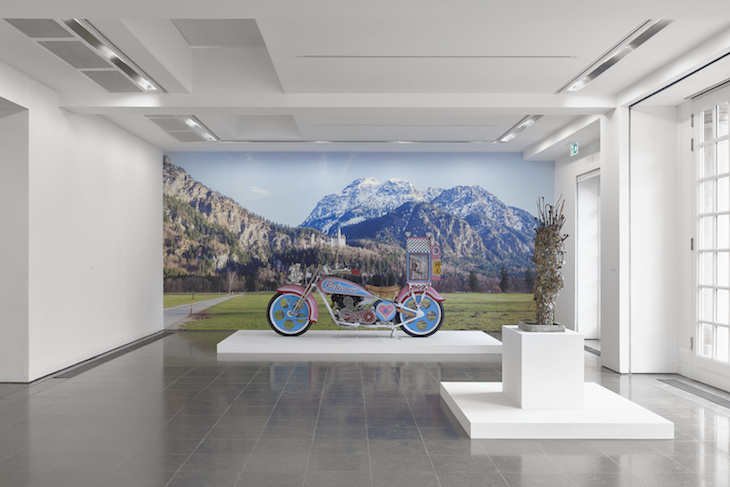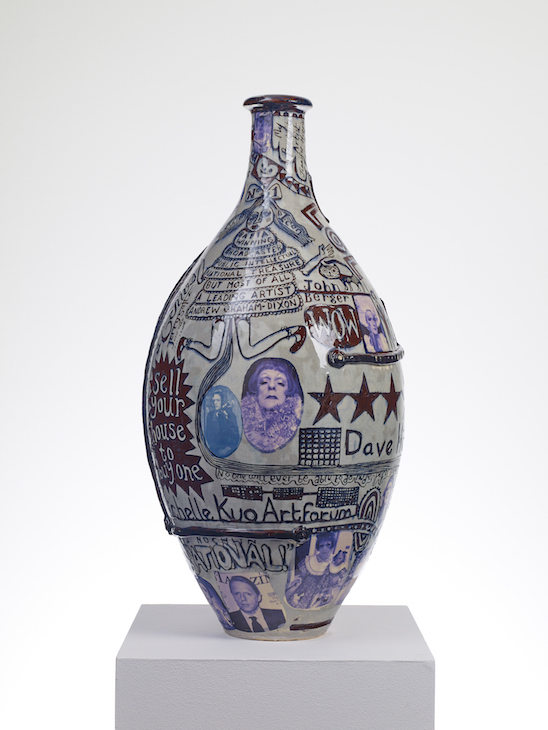Grayson Perry’s new exhibition at the Serpentine Gallery, which opened rather fortuitously on the day of the UK’s general election, has the tongue-in-cheek title ‘The Most Popular Art Exhibition Ever!’ Addressing cultural divides in our current febrile climate, the title reflects a long-held ambition on the part of the artist ‘to widen the audience for art without dumbing it down’.
Perry is, of course, a well-known artist and TV personality, recognised for his folk-inspired artworks as well as his alter-ego, Claire. There are works on display here that speak to his public persona, from a self-portrait of the artist as a reclining nude, complete with male and female attributes, to a fanciful motorbike he rode around Bavaria for a BBC Radio 4 programme.

Grayson Perry, Installation view, Serpentine Gallery, London. Image: © 2017 Robert Glowacki
This exhibition was also preceded by the TV documentary Divided Britain, which aired recently on Channel 4 and which provides a contextual framework for much of Perry’s work. (Other pieces on view concerning masculinity were produced for the artist’s 2016 TV series, All Man). In Divided Britain, Perry sought the participation of Brexiteers and Remainers via social media to help him create the centrepiece of the Serpentine show, a pair of ceramic vases decorated with images of the participants as well as things they love about Britain. Winston Churchill, David Bowie, Marmite, the BBC and NHS logos all make an appearance. Though it’s clear which vase corresponds to which camp — Nigel Farage graces one, Gina Miller the other — they are both fairly similar. Yet it is the faces of the participants that stand out. ‘That’s me, that’s my dog!’ exclaimed one, on seeing the work in the gallery for the first time during the programme. ‘That’s amazing, that’s close to immortality,’ said another.
That people can recognise themselves in this exhibition, along with the inescapable faces of Trump, Farage, and Boris, may go some way to ensuring the show’s popularity. One of the first pieces to greet the viewer is Long Pig (2017), a two-headed glazed ceramic piggy bank that invites visitors to donate money through slots variously marked ‘Us’, ‘Them’, ‘Young’, ‘Old’, ‘Remain’, ‘Leave’ and so on. Beyond mere accessibility, Perry seems to understand a need on the part of the viewer to identify with an artwork, to feel capable of unpacking its message according to their experiences — in other words, to feel included, represented.

Puff Piece (2016), Grayson Perry. Photo: Stephen White; courtesy the artist and Victoria Miro, London; © Grayson Perry
Indeed, messages and slogans from the public conversation abound. Though Perry often features text in his works, this show is a rabble of competing and diffuse voices. Phrases plucked from social media appear on a map of Britain in the tapestry Red Carpet (2017). On another vase, Luxury Brands for Social Justice (2017), parodies of liberal chatter such as ‘Flat whites against racism’ decorate the surface. Even the comparatively quiet tapestry Battle of Britain (2017), a large-scale dystopian vision of a divided land, is dotted with graffiti and logos.

The Digmoor Tapestry (2016), Grayson Perry. Photo: Stephen White; © Grayson Perry
Perry also explores ways of measuring popularity within the apparently arcane art world. Visitor Figures (2016) is a ceramic vase adorned with the names of the most popular exhibitions in the previous year, positioning big-hitters such as Koons, Gormley and Kapoor up on the neck of the vase. He also indulges in some imagined praise on the art-world-baiting Puff Piece (2016). There’s an unlikely ‘Wow!’ from the late John Berger, as well as fictitious hyperbole from a range of august mouthpieces, such as Art Forum and Parkett, as well as the newspapers. The critical reception to Perry’s own show has so far been mixed, with some reviewers praising its lack of pretension, and others criticising its very legibility. The lack of consensus does not seem to be deterring people from attending (on the Sunday after it opened, there was a queue outside the gallery), a fact which perhaps underscores the divide between the much-maligned ‘experts’, and a more ‘authentic’ public who may be happy to identify with Perry’s shorthand.
‘Grayson Perry: The Most Popular Art Exhibition Ever!’ is at the Serpentine Gallery, London, until 10 September.














![Masterpiece [Re]discovery 2022. Photo: Ben Fisher Photography, courtesy of Masterpiece London](http://zephr.apollo-magazine.com/wp-content/uploads/2022/07/MPL2022_4263.jpg)
Suzanne Valadon’s shifting gaze